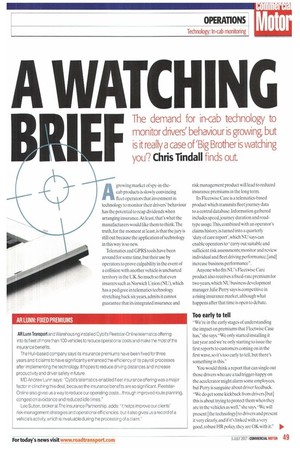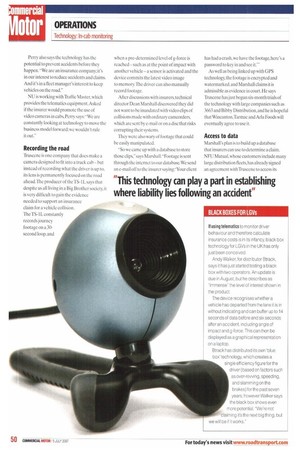A WATCH NG
Page 53

Page 54

Page 55

If you've noticed an error in this article please click here to report it so we can fix it.
FThe demand for in-cab technology to monitor drivers' behaviour is growing but is it really a case of 'Big Brother is watching you? Chris Tindall finds out Agrowing market of spy-in-thecab products is slowly convincing fleet operators that investment in technology to monitor their drivers' behaviour has the potential to reap dividends when arranging insurance.At least, that's what the manufacturers would like them to think.The truth, for the moment at least, is that the jury is still out because the application of technology in this way is so new.
Telematics and GPRS tools have been around for some time, but their use by operators to prove culpability in the event of a collision with another vehicle is uncharted territory in the UK. So much so that even insurers such as Norwich Union (NU), which has a pedigree in telematics technology stretching back six years, admits it cannot guarantee that its integrated insurance and risk management product will lead to reduced insurance premiums in the long term.
Its Fleetwise Care is a telematics-based product which transmits fleet journey data to a central database. Information gathered includes speed,journey duration and roadtype usage.This, combined with an operator's claims history, is turned into a quarterly 'duty of care report', which NU says can enable operators to "carry out suitable and sufficient risk assessments; monitor and review individual and fleet driving performance; [and] increase business performance".
Anyone who fits NU's Fleetwise Care product also receives a fixed-rate premium for two years, which NU business development manager Julie Perry says is competitive in a rising insurance market, although what happens after that time is open to debate.
Too early to tell
"We're in the early stages of understanding the impact on premiums that Fleetwise Case has," she says. "We only started installing it last year and we're only starting to issue the first reports to customers coming on in the first wave, so it's too early to tell, but there's something in this."
You would think a report that can single out those drivers who are a tad trigger-happy on the accelerator might alarm some employees, but Perry is sanguine about driver feedback. "We do get some kickback from drivers [but] this is about trying to protect them when they are in the vehicles as well," she says."Wc will present [the technology] to drivers and present it very clearly, and if it's linked with a very good, robust HR policy, they are OK with it." Perry also says the technology has the potential to prevent accidents before they happen. "We are an insurance company; it's in our interest to reduce accidents and claims. And it's in a fleet manager's interest to keep vehicles on the road."
NU is working with Traffic Master, which provides the telematics equipment.Asked if the insurer would promote the use of video cameras in cabs. Perry says: "We are constantly looking at technology to move the business model forward:we wouldn't rule it out."
Recording the road "Ii-uscene is one company that does make a camera designed to fit into a truck cab — but instead of recording what the driver is up to, its lens is permanently focused on the road ahead:The producer of the TS-1L says that despite us all living in a Big Brother society, it is very difficult to gain the evidence needed to support an insurance claim for a vehicle collision. The TS-1L constantly records journey footage on a 30second loop, and when a pre-determined level of g-force is reached — such as at the point of impact with another vehicle — a sensor is activated and the device commits the latest video image to memory.The driver can also manually record footage.
After discussions with insurers, technical director Dean Marshall discovered they did not want to be inundated with video clips of collisions made with ordinary camcorders, which are sent by e-mail or on a disc that risks corrupting their systems.
They were also wary of footage that could be easily manipulated.
"So we came up with a database to store those clips," says Marshall."Footage is sent through the internet to our database. We send an e-mail off to the insurer saving:`Your client has had a crash, we have the footage, here's a password to key in and see it.— As well as being linked up with GPS technology, the footage is encrypted and watermarked, and Marshall claims it is admissible as evidence in court. He says Truscene has just begun six-month trials of the technology with large companies such as 3663 and Bibby Distribution,and he is hopeful that Wincanton,Tarmac and Aria Foods will eventually agree to use it.
Access to data Marshall's plan is to build up a database that insurers can use to determine a claim. NFU Mutual, whose customers include many large distribution fleets, has already signed an agreement with Truscene to access its If using telematies to monitor driver behaviour and therefore calculate insurance costs is in its infancy, black box technology for LGVs in the UK has only just been conceived.
Andy Walker, for distributor Btrack, says it has just started testing a black box with two operators. An update is due in August, but he describes as "immense" the level of interest shown in the product.
The device recognises whether a vehicle has departed from the lane it is in without indicating and can buffer up to 14 seconds of data before and six seconds after an accident, including angle of impact and g-force. This can then be displayed as a graphical representation on a laptop.
Btrack has distributed its own 'blue box' technology, which creates a 111 single efficiency figure for the 1 driver (based on factors such as over-revving, speeding, and slamming on the brakes) for the past seven years; however Walker says the black box shows even , more potential. "We're not • 'claiming it's the next big thing, but we will be if it works." website and video footage should a policy holder or third party approach it over a disputed claim.
Marshall says: "The most important figures we have show that ilbn a year is spent on fraudulent claims. It's costing insurers a fortune to find out what happened." He believes the TS-1L has three unique selling points. "It's removable from a vehicle so it can film the outside as well; the database is linked to insurance companies; and we have the Facility for the camera to start recording when the vehicle is left unattended."
He calculates the cost of having the TS-1L installed as a fleet package at around 50p per day but stops short of claiming installation would lead to falling insurance premiums. "liltimately,everyone wants to know what caused the crash," he says. "It's stressful for all parties. If the [driver] didn't cause it, it will be beneficial for them. If they did, it could be used as part of a training programme for them."
What is Wincanton's opinion on such technology? A spokesman says:"While we have been trialling this sort of technology, Wincanton's focus is on preventing accidents rather than recording them — and we believe our investment should be directed towards driver training."
Establishing liability
Bob Phillips. chief staff engineer at NFU Mutual, says it hasn't endorsed the but adds: "Certainly it can play a part in establishing where liability lies following a road accident."
He says the product could be useful when insurers are assessing whether a 'staged accident' has taken place and also the "rights and wrongs of what happened".
However, he believes the very newness of this and similar products creates a problem. "It's a chicken-and-egg situation. It's unproven, and until you get a few out there into the marketplace you are going to struggle. As far as the concept goes, we think it is good; it potentially offers benefits to policy holders and may help to protect policy holders and contain costs. It's particularly useful for large fleet users, but it could come at quite a cost. 'there's a balance there for a fleet operator."
Phillips is more open to discussing the potential for reduced premiums for businesses using the technology. "As far as fleet operators go, it would have that potential, because big fleet policyholders have a significant rating based on experience from the last few years. If a big fleet operator can show it has a good claim record, then yes, it may affect the premium."
But Andy Walker, head of sales and marketing at vehicle monitoring technology distributor Btrack, cautions against claims of insurance discounts."1 am not suggesting there aren't customers with 10% reductions," he says."My point is. don't think that just because you fit a system that's what you will get. A lot of people don't realise those discounts aren't set in stone.
Referring to the newness of the products. Walker says:"It's all a pilot. It's actually at the discretion of the broker. An insurance company could say,'bloody hell, we didn't realise it was that •






























































































































































































